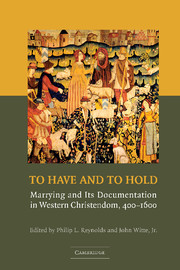Book contents
- Frontmatter
- Contents
- List of Contributors
- Preface and Acknowledgments
- List of Abbreviations
- 1 Marrying and Its Documentation in Pre-Modern Europe: Consent, Celebration, and Property
- 2 Marrying and Its Documentation in Later Roman Law
- 3 Marrying and the Tabulae Nuptiales in Roman North Africa from Tertullian to Augustine
- 4 Dotal Charters in the Frankish Tradition
- 5 Marriage and Diplomatics: Five Dower Charters from the Regions of Laon and Soissons, 1163–1181
- 6 Marriage Agreements from Twelfth-Century Southern France
- 7 Marriage Contracts in Medieval England
- 8 Marriage Contracts and the Church Courts of Fourteenth-Century England
- 9 Marrying and Marriage Litigation in Medieval Ireland
- 10 Marriage Contracts in Medieval Iceland
- 11 Contracting Marriage in Renaissance Florence
- 12 Marital Property Law as Socio-Cultural Text: The Case of Late-Medieval Douai
- 13 Marriage Contracts, Liturgies, and Properties in Reformation Geneva
- Index
12 - Marital Property Law as Socio-Cultural Text: The Case of Late-Medieval Douai
Published online by Cambridge University Press: 12 September 2009
- Frontmatter
- Contents
- List of Contributors
- Preface and Acknowledgments
- List of Abbreviations
- 1 Marrying and Its Documentation in Pre-Modern Europe: Consent, Celebration, and Property
- 2 Marrying and Its Documentation in Later Roman Law
- 3 Marrying and the Tabulae Nuptiales in Roman North Africa from Tertullian to Augustine
- 4 Dotal Charters in the Frankish Tradition
- 5 Marriage and Diplomatics: Five Dower Charters from the Regions of Laon and Soissons, 1163–1181
- 6 Marriage Agreements from Twelfth-Century Southern France
- 7 Marriage Contracts in Medieval England
- 8 Marriage Contracts and the Church Courts of Fourteenth-Century England
- 9 Marrying and Marriage Litigation in Medieval Ireland
- 10 Marriage Contracts in Medieval Iceland
- 11 Contracting Marriage in Renaissance Florence
- 12 Marital Property Law as Socio-Cultural Text: The Case of Late-Medieval Douai
- 13 Marriage Contracts, Liturgies, and Properties in Reformation Geneva
- Index
Summary
The texts of marital property law are, by nature, reluctant witnesses to marriage's social and cultural meanings. The statutes, legal commentaries, litigation records, court judgments, and individualized documents such as marriage contracts and wills that make up this body of law are typically formulaic summaries of the rules governing property's transmission via marriage. Alone, any such record does not tell us much about whether the rules were followed or how they affected the way husbands and wives or parents and children related to one another. The scarcity of such records from premodern Europe compounds these problems of interpretation. Until the last centuries of the epoch, the surviving documents are widely scattered across geographic and chronological space, and, in any case, they treat only a tiny, elite sector of society, which almost surely cannot stand for the whole.
One of the rare exceptions to this rule in northern Europe is late-medieval Douai: an important French-speaking city in the medieval county of Flanders (and now part of France), and the home of a kind of marital property law especially favored in the North. Thanks to an extraordinary collection of documents left by the citizenry, we are able to look closely at how such property laws worked to express and construct marriage's meaning, not just in Douai but, by extension, in other areas where the record is much spottier: in French-speaking Flanders and northern France where the Douaisien story has immediate relevance, but also in nearby German- and Dutch-speaking areas and in parts of England.
- Type
- Chapter
- Information
- To Have and to HoldMarrying and its Documentation in Western Christendom, 400–1600, pp. 421 - 452Publisher: Cambridge University PressPrint publication year: 2007



